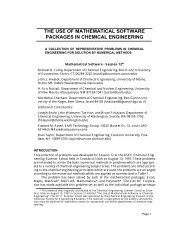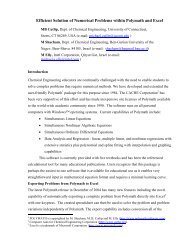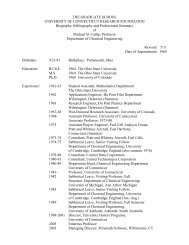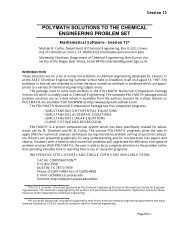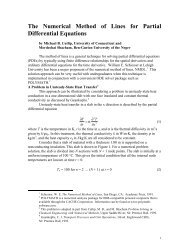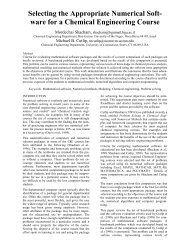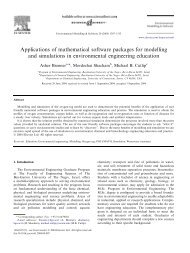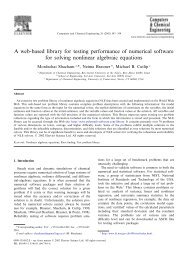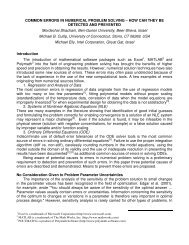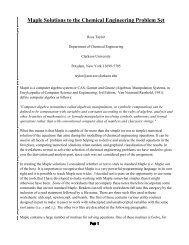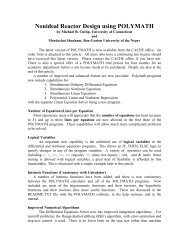MATHEMATICA SOLUTIONS TO THE CHEMICAL ENGINEERING ...
MATHEMATICA SOLUTIONS TO THE CHEMICAL ENGINEERING ...
MATHEMATICA SOLUTIONS TO THE CHEMICAL ENGINEERING ...
Create successful ePaper yourself
Turn your PDF publications into a flip-book with our unique Google optimized e-Paper software.
INTRODUCTION<br />
<strong>MA<strong>THE</strong>MATICA</strong> <strong>SOLUTIONS</strong> <strong>TO</strong> <strong>THE</strong> <strong>CHEMICAL</strong><br />
<strong>ENGINEERING</strong> PROBLEM SET 1<br />
H. Eric Nuttall<br />
Department of Chemical/Nuclear Engineering<br />
Farris Engineering Center, Rm 209<br />
University of New Mexico<br />
Albuquerque, New Mexico 87131-1341<br />
These solutions are for a set of numerical problems in chemical engineering.<br />
Professor Michael B. Cutlip of the University of Connecticut developed the problems and<br />
Professor Mordechai Shacham of Ben-Gurion University of the Negev for the ASEE<br />
Chemical Engineering Summer School held in Snowbird, Utah in August, 1997. The<br />
problem statements are provided in another document. 1 Professors Cutlip and Shacham<br />
provided a document that showed how to solve the problems using POLYMATH.<br />
Professor H. Eric Nuttall of the University of New Mexico provided solutions using<br />
Mathematica and Professor J. J. Hwalek provided solutions using Mathcad. After the<br />
conference, Professor Ross Taylor provided solutions in Maple, and Edward Rosen<br />
provided solution in EXCEL. This paper gives the solutions in <strong>MA<strong>THE</strong>MATICA</strong> version<br />
3.0. All documents and solutions are available from http://www.che.utexas.edu/cache/ and<br />
via FTP from ftp.engr.uconn.edu/pub/ASEE. The written materials are only readable in<br />
Adobe Acrobat 3.0 format and higher; however, this software is free via the Internet from<br />
www.adobe.com.<br />
The <strong>MA<strong>THE</strong>MATICA</strong> solutions were derived using version 3.0. This version of<br />
<strong>MA<strong>THE</strong>MATICA</strong> is the same on all platforms; hence, the notebooks should work the<br />
same for all users independent of computer model. <strong>MA<strong>THE</strong>MATICA</strong> is a very extensive<br />
and comprehensive computational tool; hence, there are several possible approaches and<br />
various routines in <strong>MA<strong>THE</strong>MATICA</strong> available for solving each of the ten problems. The<br />
approach chosen here is that of the author which means other solutions may prove to be<br />
better. Also please note that in addition to using the routines provided by<br />
<strong>MA<strong>THE</strong>MATICA</strong> one can easily write there own programs/functions. This programming<br />
capability greatly extends the usefulness of <strong>MA<strong>THE</strong>MATICA</strong>. Numerous primers and<br />
publications are available to instruct the user on the operation of <strong>MA<strong>THE</strong>MATICA</strong>. Also<br />
the online help system is very comprehensive and includes numerous examples for each<br />
command. I have found <strong>MA<strong>THE</strong>MATICA</strong> to be an indispensable computational tool for<br />
teaching and solving engineering problems. All of our Ch.E. students at the University of<br />
New Mexico know and use <strong>MA<strong>THE</strong>MATICA</strong>. This prefer this package overall the others<br />
which are also equally available to the students.<br />
1 “The Use of Mathematica Software packages in Chemical Engineering”. Michael B.<br />
Cutlip, John J. Hwalek, H. Eric Nuttall, Mordechai Shacham, Workshop from Session 12,<br />
Chemical Engineering Summer School, Snowbird, Utah, Aug., 1997.<br />
M i
Mathematica ASEE Session 12--Problem 1 M 1<br />
1. Molar Volume and Compressibility Factor from<br />
Van Der Waals Equation<br />
Mathematica<br />
Mathematica has its own notebook interface which works somewhat as a wordprocessor<br />
but allows mathematical operations directly within the notebook. In addition, it uses the<br />
concept of built in or user written functions to perform the mathematical tasks. Note that<br />
in these notebooks the gray sections are input and the next line will be output.<br />
Mathematica has a good on-line help utility but to learn how to effectively use this<br />
application it is best to read one of the many help books such as: Nancy Blachman,<br />
Mathematica: A Practical Approach, Prentice Hall. A new edition for Mathematica<br />
version 3.0 will be available soon.<br />
Ÿ Mathematica--Define equation, paramters and functions<br />
H* define all the constants used in the equation and<br />
the compressibility factor as a function. Note it<br />
is possible to include units with the constants<br />
but this was not done in these problems. *L<br />
R = 0.08206; Tc = 405.5; Pc = 111.3; Pr@P_D := P Pc;<br />
a = 27 HR^2 Tc^2 PcL 64; b = RTc H8 PcL;<br />
Z@P_, V_, T_D := PV HRTL; T=.; P =.;<br />
H* van der Waals equation *L<br />
eqn = HP + a V^2L HV - bL == RT<br />
JP + 4.19695<br />
€€€€€€€€€€€€€€€€€€€€€€€ NH-0.0373712 + VL == 0.08206 T<br />
V 2
Mathematica ASEE Session 12--Problem 1 M 2<br />
Ÿ Part (a)--Calculate the molar volume and compressibility factor for<br />
gaseous ammonia at a pressure of P=56 atm and a temperature of T=<br />
450 K using the van der Waals equation of state.<br />
H* temperature and pressure *L<br />
T = 450; P = 56;<br />
H* Solve vad der Waals equation *L<br />
FindRoot@eqn, 8V, 0.57
Mathematica ASEE Session 12--Problem 1 M 3<br />
H* Create table of P, Pr V and Z *L<br />
TableForm@Table@8P = Pr@iD Pc,<br />
Pr@iD, V1= V . FindRoot@eqn, 8V, 0.56
Mathematica ASEE Session 12--Problem 1 M 4<br />
ListPlot@plist, PlotRange -> 880, 20 AutomaticD<br />
3<br />
2.5<br />
2<br />
1.5<br />
1<br />
0.5<br />
… Graphics …<br />
2.5 5 7.5 10 12.5 15 17.5 20
Mathematica ASEE Session 12--Problem 2 M 5<br />
2. Steady Steate Material Balances on a Separation<br />
Train<br />
Mathematica<br />
à This set of simultaneous linear algebraic equations can<br />
be solved directly using the "Solve" function in<br />
Mathematica. There are other linear equation solving<br />
routines in Mathematica that could be used for larger sets<br />
of simultaneous equations and of course, matrix algebra<br />
approach could be used as well. But the method shown is<br />
the most common routine and approach in Mathematica<br />
for solving equations. Since Mathematica is a symbolic<br />
program one can assign the equations equal to variables<br />
to simplicity and clarification.<br />
à Part (a) Solve the set of linear simultaneous equations<br />
for the unknowns: D1, D2, B1, B2.<br />
H* Xylene*L<br />
eqnX =0.07 D1+0.18 B1+0.15 D2+0.24 B2 == 0.15*70;<br />
H* Styrene*L<br />
eqnS =0.04 D1+0.24 B1+0.1 D2+0.65 B2 == 0.25*70;<br />
H* Touene *L<br />
eqnT =0.54 D1+0.42 B1+0.54 D2+0.1 B2 == 0.4*70;<br />
H* Benzene*L<br />
eqnB =0.35 D1+0.16 B1+0.21 D2+0.01 B2 == 0.2*70;
Mathematica ASEE Session 12--Problem 2 M 6<br />
answers =<br />
Solve@8eqnX, eqnS, eqnT, eqnB
Mathematica ASEE Session 12--Problem 2 M 7<br />
H* Again the "Solve " function is used.<br />
It is necessary to substitute into the<br />
equations the solutions from Part HaL. *L<br />
answers2 =Solve@<br />
ReplaceAll@8eqn1, eqn2, eqn3, eqn4, eqn5, eqn6, eqn7,<br />
eqn8, eqn9, eqn10
Mathematica ASEE Session 12--Problem 3 M 8<br />
3. Vapor Pressure Data Representaton by<br />
Polynomials and Equations<br />
Mathematica<br />
In this problem the same temperature versus pressure data is fit using three different<br />
models, i.e.,<br />
1) a polynomial with increasing order--linear regression<br />
2) the Clausiu-Clapeyron equation--linear regression of transformed data<br />
3) the Antoine equation--nonlinear regression or curve fitting<br />
In each case, the final model and data are graphed on the same plot for comparison.<br />
à Part (a)--polynomial fit<br />
Ÿ Define the regression data--Temperature (C) versus P (mm Hg)<br />
data =88-36.7, 1
Mathematica ASEE Session 12--Problem 3 M 9<br />
data TableForm H* T versus P *L<br />
-36.7 1<br />
-19.6 5<br />
-11.5 10<br />
-2.6 20<br />
7.6 40<br />
15.4 60<br />
26.1 100<br />
42.2 200<br />
60.6 400<br />
80.1 760<br />
H* Plot T versus P *L<br />
p1 =ListPlot@data, PlotStyle -> PointSize@0.035D,<br />
PlotRange -> 88-50, 100
Mathematica ASEE Session 12--Problem 3 M 10<br />
H* first order polynomial in T,<br />
RSquared=0.78 *L<br />
T=.;<br />
Hregress = Regress@data, 81, T
Mathematica ASEE Session 12--Problem 3 M 11<br />
H* Second order polynomial in T,<br />
RSquared=0.98 *L<br />
regress = Regress@data, 81, T, T^2
Mathematica ASEE Session 12--Problem 3 M 12<br />
H* Third order polynomial in T,<br />
RSquared=0.9996-- This is a very good fit *L<br />
regress =Regress@data, 81, T, T^2, T^3
Mathematica ASEE Session 12--Problem 3 M 13<br />
H* This is a fancy way to overlay<br />
the data onto the polynomial function *L<br />
p2 =Plot@eqn1, 8T, -50, 100
Mathematica ASEE Session 12--Problem 3 M 14<br />
Ÿ In this next operation the data is transformed to temperature versus<br />
log 10 of pressure<br />
H* Take the log10 of each pressure *L<br />
Transdata =<br />
Table@8First@data@@iDDD,<br />
Log@10, Last@data@@iDDDD
Mathematica ASEE Session 12--Problem 3 M 15<br />
H* Plot Clausius-<br />
Clapayron model and transformed data *L<br />
Plot@8.7520 -2035.331*invTK 1000,<br />
8invTK, 2.6, 4.3 882.6, 4.6
Mathematica ASEE Session 12--Problem 3 M 16<br />
NonlinearRegress@Transdata, A-B HT+CL, T,<br />
88A, 5
Mathematica ASEE Session 12--Problem 3 M 17<br />
à The above values for A, B, and C differ from those<br />
calculated by Polymath. Below I set C equal to the<br />
Polymath value (153.885) and calculated A and B. This<br />
procedure gave the same results as Polymath.<br />
H* Values for A and B<br />
the same as calculated from Polymath *L<br />
NonlinearRegress@<br />
Transdata, A-B HT+153.885L, T, 8A, B
Mathematica ASEE Session 12--Problem 3 M 18<br />
à Below is a plot showing that the two solutions are<br />
essentially identical and that they fit the data very well.<br />
H* Note that the Antonine equation with different<br />
constants gives essentially identical results *L<br />
pc2 =PlotA<br />
677.0908<br />
95.76734 - €€€€€€€€€€€€€€€€€€€€€€€€€€€€€€€€€€€€€ ,5.64227 -<br />
153.8849 +Tc<br />
8Tc, -40, 80
Mathematica ASEE Session 12--Problem 3 M 19<br />
ŸNext the data is overlayed onto the Antoine equation<br />
pc1 =ListPlot@Transdata, PlotStyle -> PointSize@0.035D,<br />
PlotRange -> 88-60, 90
Mathematica ASEE Session 12--Problem 4 M 20<br />
4. Reaction Equilibrium for Multiple Gas Phase<br />
Reactions<br />
Mathematica<br />
This problem requires the solution of simultaneous nonlinear algebraic equations. The<br />
Mathematica function FindRoot is used to solve these equations. Use the online help to<br />
learn more about the built-in FindRoot utility function.
Mathematica ASEE Session 12--Problem 4 M 21<br />
Ÿ For the equations see the problem statement EQUATIONS (12)<br />
ŸSetup equations for solving using Mathematica<br />
FindRoot function. Note that the numerical values for certain<br />
constants are given and assigned below along with the necessary<br />
equations.<br />
f1 =Cc Cd-Kc1 Ca Cb == 0;<br />
f2 =Cx Cy-Kc2 Cb Cc == 0;<br />
f3 =Cz-Kc3 Ca Cx == 0;<br />
eqn4 =Ca == Ca0 -Cd-Cz;<br />
eqn5 =Cb == Cb0 -Cd-Cy;<br />
eqn6 =Cc == Cd-Cy;<br />
eqn7 =Cy == Cx+Cz;<br />
Ca0 =Cb0 =1.5;<br />
Kc1 =1.06;<br />
Kc2 =2.63;<br />
Kc3 =5;<br />
à Parts-(a), (b) and (c)<br />
à Solve using the three different starting values for CD,<br />
CX and CZ<br />
Ÿ Trial #1<br />
answera =<br />
FindRoot@8f1, f2, f3, eqn4, eqn5, eqn6, eqn7
Mathematica ASEE Session 12--Problem 4 M 22<br />
ŸTrial #2<br />
Ÿ Trial #3<br />
answerb =<br />
FindRoot@8f1, f2, f3, eqn4, eqn5, eqn6, eqn7
Mathematica ASEE Session 12--Problem 5 M 23<br />
5. Terminal Velocity of Falling Particles<br />
Mathematica<br />
Ÿ Mathematica has many special capabilities. For this problem, user<br />
written conditional functions are used. The problem is nonlinear<br />
because the particle velocity appears both in the equation and<br />
embedded in the Reynolds number which appears in the drag<br />
coeficient equation. Hence a very nonlinear problem!<br />
First, define the Drag Coefficient function for various ranges of Re<br />
using the conditional function construct.<br />
CD@Re_D := 24 Re ;Re 9.80665<<br />
8r ®994.6, rp ®1800, Ю0.000893, Dp ®0.000208,<br />
g®9.80665<<br />
Unprotect@ReD; H* if we wish to use the symbol<br />
"Re" we must unprotect it. In Mathematica<br />
this symbol is already defined *L
Mathematica ASEE Session 12--Problem 5 M 24<br />
Ÿ Define equations: Reynolds number and particle velocity<br />
eqn1 =Re == Dp vt r Ð<br />
Re ==<br />
Dpvt r<br />
€€€€€€€€€€€€€€€€€€€<br />
Ð<br />
eqn2 =vt == Sqrt@4 g Hrp-rL Dp H3 CD@ReD rLD<br />
vt ==<br />
++++++++++++++++++++++++++<br />
Dp gH-r+rpL<br />
2 $ €€€€€€€€€€€€€€€€€€€€€€€€€€<br />
rCD@ReD<br />
€€€€€€€€€€€€€€€€€€€€€€€€€€€€€€€€€€€€€€€€ +++<br />
3<br />
Ÿ Solve the nonlinear equations simultaneously-Part (a)<br />
solution =FindRoot@Evaluate@8eqn1, eqn2< .dataD,<br />
8Re, 81, 1000
Mathematica ASEE Session 12--Problem 5 M 25<br />
Ÿ Plot function velocity equation versus vt to graphically verify the<br />
calculated solution.<br />
H* This plot is just a fun and visually instructive<br />
way to see graphically the correct solution *L<br />
Plot@<br />
vt-Sqrt@4 g Hrp-rL Dp H3 CD@Dp vt r ÐD rLD .data .<br />
data, 8vt, 0.000, 0.02 CD@ReD .solution
Mathematica ASEE Session 12--Problem 5 M 26<br />
à Part (b)--Recalculate the problem assuming gravity is<br />
30 times greater<br />
data2 =8r -> 994.6 ,rp -> 1800, Ð-> 8.93*10^-4 ,<br />
Dp -> 0.208*10^-3, g-> 30*9.80665<<br />
8r ®994.6, rp ®1800, Ю0.000893, Dp ®0.000208,<br />
g®294.199<<br />
solutionb =FindRoot@Evaluate@8eqn1, eqn2< .data2D,<br />
8Re, 81, 1000
Mathematica ASEE Session 12--Problem 6 M 27<br />
6. Heat Exchange in a Series of Tanks<br />
Mathematica<br />
This problem requires the solution of simultaneous first order differential equations.<br />
Ÿ Define in Mathematica the differentional equations (20), (21), and (22)<br />
from problem statement. The three equations are assigned for<br />
convenience to the variables eqn1, eqn2, and eqn3.<br />
eqn1 =<br />
T1'@tD == HW Cp HTo-T1@tDL+UA HTs-T1@tDLL HM CpL<br />
T1 ¢ @tD ==<br />
CpWHTo-T1@tDL+UA HTs-T1@tDL<br />
€€€€€€€€€€€€€€€€€€€€€€€€€€€€€€€€€€€€€€€€€€€€€€€€€€€€€€€€€€€€€€€€€€€€€€€€€€€€€€€€€€€€€€€€€€€<br />
Cp M<br />
eqn2 =<br />
T2'@tD == HW Cp HT1@tD-T2@tDL+UA HTs-T2@tDLL HM CpL<br />
T2 ¢ @tD ==<br />
UAHTs-T2@tDL+Cp WHT1@tD-T2@tDL<br />
€€€€€€€€€€€€€€€€€€€€€€€€€€€€€€€€€€€€€€€€€€€€€€€€€€€€€€€€€€€€€€€€€€€€€€€€€€€€€€€€€€€€€€€€€€€€€€€€€€€€<br />
Cp M<br />
eqn3 =<br />
T3'@tD == HW Cp HT2@tD-T3@tDL+UA HTs-T3@tDLL HM CpL<br />
T3 ¢ @tD ==<br />
Ÿ Steady-state equations<br />
UAHTs-T3@tDL+Cp WHT2@tD-T3@tDL<br />
€€€€€€€€€€€€€€€€€€€€€€€€€€€€€€€€€€€€€€€€€€€€€€€€€€€€€€€€€€€€€€€€€€€€€€€€€€€€€€€€€€€€€€€€€€€€€€€€€€€€<br />
Cp M<br />
eqn1s =0== HW Cp HTo-T1@tDL +UA HTs -T1@tDLL HM CpL<br />
0==<br />
CpWHTo-T1@tDL +UA HTs-T1@tDL<br />
€€€€€€€€€€€€€€€€€€€€€€€€€€€€€€€€€€€€€€€€€€€€€€€€€€€€€€€€€€€€€€€€€€€€€€€€€€€€€€€€€€€€€€€€€€€<br />
Cp M
Mathematica ASEE Session 12--Problem 6 M 28<br />
eqn2s =0== HW Cp HT1@tD-T2@tDL +UA HTs -T2@tDLL HM CpL<br />
0==<br />
UAHTs-T2@tDL+Cp WHT1@tD-T2@tDL<br />
€€€€€€€€€€€€€€€€€€€€€€€€€€€€€€€€€€€€€€€€€€€€€€€€€€€€€€€€€€€€€€€€€€€€€€€€€€€€€€€€€€€€€€€€€€€€€€€€€€€€<br />
Cp M<br />
eqn3s =0== HW Cp HT2@tD-T3@tDL +UA HTs -T3@tDLL HM CpL<br />
0==<br />
Ÿ Define parameters<br />
UAHTs-T3@tDL+Cp WHT2@tD-T3@tDL<br />
€€€€€€€€€€€€€€€€€€€€€€€€€€€€€€€€€€€€€€€€€€€€€€€€€€€€€€€€€€€€€€€€€€€€€€€€€€€€€€€€€€€€€€€€€€€€€€€€€€€€<br />
Cp M<br />
data =8W -> 100, Cp -> 2,<br />
To -> 20, UA -> 10, Ts -> 250, M-> 1000,<br />
T1o -> 20, T2o -> 20, T3o -> 20<<br />
8W ®100, Cp ®2, To ®20, UA ®10, Ts ®250, M®1000,<br />
T1o ®20, T2o ®20, T3o ®20<<br />
Ÿ Solve the differential equations<br />
solutions =NDSolve@Evaluate@8eqn1, T1@0D == T1o, eqn2,<br />
T2@0D == T2o, eqn3, T3@0D == T3o< .dataD,<br />
8T1, T2, T3
Mathematica ASEE Session 12--Problem 6 M 29<br />
Ÿ Plot results<br />
Plot@Evaluate@<br />
8T1@tD, T2@tD, T3@tD< .solutionsD, 8t, 0, 60 880, 60
Mathematica ASEE Session 12--Problem 6 M 30<br />
H* This statement<br />
solves the three steady state equations *L<br />
NSolve@Evaluate@8eqn1s, eqn2s, eqn3s< .dataD,<br />
8T1@tD, T2@tD, T3@tD
Mathematica ASEE Session 12--Problem 6 M 31<br />
Ÿ Part (b)--Answer 63 minutes<br />
H* Solve for the<br />
time at the 99 % level using FindRoot *L<br />
FindRoot@Evaluate@0 == 50.804 -T3@tD .solutionsD,<br />
8t, 80, 70
Mathematica ASEE Session 12--Problem 7 M 32<br />
7. Diffusion with Chemical Reaction in a One<br />
Dimensional Slab<br />
Mathematica<br />
This problem requires the solution of a second order boundary value problem.<br />
Mathematica doesn't come with a built-in routine for numerically solving boundary value<br />
problems; however, Mathematica can analytically solve this BVP. Hence to numerically<br />
solve the problem I wrote a small program within Mathematica. As you will see writing<br />
programs in Mathematica requires very few statements since one has access to numerous<br />
Mathematica routines. I assume that others have already written excellent boundary value<br />
solution routines for Mathematica and I assume these are available on the WEB.<br />
Ÿ Define equation<br />
eqn =Ca''@zD == Hk DabL Ca@zD<br />
Ca ² @zD == kCa@zD<br />
€€€€€€€€€€€€€€€€€€€€€<br />
Dab<br />
Ÿ Define data<br />
data =<br />
8Cao -> 0.2, k-> 0.001, Dab -> 1.2*10^-9, L-> 10^-3<<br />
9Cao ®0.2, k®0.001, Dab ®1.2´10 -9 ,L®<br />
1<br />
€€€€€€€€€€€€€<br />
1000 =
Mathematica ASEE Session 12--Problem 7 M 33<br />
àNote one needs to write a small program in<br />
Mathematica to solve boundary value problem.<br />
Ÿ Test to see if Mathematica (Mma) can correctly solve the second order<br />
bound value equation as an initial value ODE.<br />
temp =NDSolve@<br />
Evaluate@8eqn, Ca@0D == Cao, Ca'@0D == -132< .dataD,<br />
Ca@zD, 8z, 0, 10^-3
Mathematica ASEE Session 12--Problem 7 M 34<br />
Ÿ Test this function<br />
Fun@-140D<br />
-11.6998<br />
FindRoot@Fun@DCaD, 8DCa, 8-125, -140
Mathematica ASEE Session 12--Problem 7 M 35<br />
à Second solution technique<br />
Ÿ Modify the problem into a minimization problem<br />
FunM@DCa_D := Block@8
Mathematica ASEE Session 12--Problem 7 M 36<br />
Ÿ Plot the solution over the variable z (This completes Part (a))<br />
H* Plotted here is the<br />
numerical solution to the BVP problem. *L<br />
Plot@Ca@zD .temp, 8z, 0, 10^-3 880, 10^-3
Mathematica ASEE Session 12--Problem 7 M 37<br />
Plot@8Ca@zD .temp, Canalytical@zD
Mathematica ASEE Session 12--Problem 7 M 38<br />
Ÿ Table comparsion of the numerical and analytical solutions<br />
TableForm@Table@8First@Ca@zD .tempD, Canalytical@zD
Mathematica ASEE Session 12--Problem 8 M 39<br />
8. Binary Batch Distillation<br />
Mathematica<br />
This problem requires the simultaneous solution of an ordinary differential equaiton with<br />
nonlinear algebraic equations. My approach was to write the nonlinear algebraic<br />
equations as a user written Mathematica function that could then be called from<br />
Mathematica's numerical ordinary differential equaiton solver.<br />
Ÿ In this problem, k2 is a function of x2. A special function is written<br />
and the problem is solved in Mathematica's NDSolve (numerical<br />
differential equation solver).<br />
Ÿ The special function defining k2 as a function of x2 is written below as<br />
kn2.<br />
kn2@xn2_?NumberQD :=<br />
Module@<br />
8data =8A1 -> 6.90565, B1 -> 1211.033, C1 -> 220.79,<br />
A2 -> 6.95464, B2 -> 1344.8, C2 -> 219.482
Mathematica ASEE Session 12--Problem 8 M 40<br />
Ÿ Once the special function is defined, the problem is solved using<br />
Mma's built-in numerical ODE solver, NDSolve .<br />
eqn2 =eqn =L'@x2D == L@x2D Hx2 Hkn2@x2D -1LL<br />
L ¢ @x2D ==<br />
L@x2D<br />
€€€€€€€€€€€€€€€€€€€€€€€€€€€€€€€€€€€€€€€€€€€€€€€€<br />
x2 H-1+kn2@x2DL<br />
solution =<br />
NDSolve@8eqn2, L@0.4D == 100
Mathematica ASEE Session 12--Problem 9 M 41<br />
9. Reversible, Exothermic, Gas Phase Reaction in a<br />
Catalytic Reactor<br />
Mathematica<br />
This problem requires the numerical solution of three nonlinear simultaneous differential equations.<br />
The advantage of the symbolic routines for this type of problem is that they can help the user with<br />
the book keeping of all the equations and variables. In this problem to make it easier to check the<br />
equations and avoid typing errors the data is treated as rules and the symbolic forum of the<br />
equations are preserved. If needed Mathematica could also track and process units; however, to<br />
streamline these calculations this is not done here.<br />
Ÿ In this case we preserve the symbolic forum of the equations by using<br />
the rule and replace capability in Mathematica<br />
Ÿ Define data as a list of rules ( the parameters in these equations are<br />
expressions of temperature and concentration)<br />
data =8k -> 0.5 Exp@5032 H1 450 -1 T@wDLD,<br />
CA -> 0.271*H1-x@wDL<br />
H450 T@wDL H1-0.5*x@wDL*y@wD, CC -><br />
0.271*0.5 x@wD*H450 T@wDL H1-0.5*x@wDL*y@wD,<br />
Kc -> 25000*Exp@delH 8.314*H1 450 -1 T@wDLD,<br />
rA -> -k*HCA^2-CC KcL, Ta -> 500<br />
delH -> -40000, CPA -> 40, FA0 -> 5<<br />
9k ®0.5 E<br />
121.95 H1-x@wDL y@wD<br />
€€€€€€€€€€€€€€€€€€€€€€€€€€€€€€€€€€€€€€€€€€€€€€€€€€€€€€€€€€€€€ ,<br />
T@wD H1-0.5 x@wDL<br />
CC ®<br />
60.975 x@wD y@wD<br />
delHI €€€€€€€€€€€ 1<br />
€€€€€€€€€€€€€€€€€€€€€€€€€€€€€€€€€€€€€€€€€€€€€€€€€€€€ ,Kc ®25000 E0.120279 450<br />
T@wD H1 -0.5 x@wDL - €€€€€€€€€€€€€€ 1<br />
T@wD M ,<br />
rA ®-kJCA 2 - CC<br />
€€€€€€€ N,Ta ®500, delH ®-40000, CPA ®40, FA0 ®5=<br />
Kc<br />
5032I €€€€€€€€€€€ 1<br />
450 - €€€€€€€€€€€€€€ 1<br />
T@wD M ,CA ®
Mathematica ASEE Session 12--Problem 9 M 42<br />
Ÿ Define differential equations. The three equations are assigned to the<br />
variable names eqn1, eqn2, and eqn3. This simplifies the users task of<br />
checking for typos and avoids re-typing.<br />
Ÿ Check eqn1<br />
eqn1 =x'@wD == -rA FA0 .data;<br />
eqn2 =T'@wD ==<br />
HH0.8 HTa-T@wDL +rA*delHL HCPA*FA0LL .data;<br />
eqn3 =y'@wD ==<br />
-0.015*H1-0.5 x@wDL HT@wD 450L H2*y@wDL .<br />
data;<br />
eqn1 H* Check Equation 1 *L<br />
x ¢ @wD ==<br />
0.1 E<br />
5032I €€€€€€€€€€€ 1<br />
450 - €€€€€€€€€€€€€€ 1 i<br />
I €€€€€€€€€€€<br />
1<br />
T@wD<br />
M 0.002439 E4811.16 450<br />
- - €€€€€€€€€€€€€€<br />
1<br />
T@wD M x@wD y@wD<br />
€€€€€€€€€€€€€€€€€€€€€€€€€€€€€€€€€€€€€€€€€€€€€€€€€€€€€€€€€€€€€€€€€€€€€€€€€€€€€€€€€€€€€€€€€€€€€€€€€€€€€€<br />
j<br />
k<br />
14871.8 H1-x@wDL2 y@wD2 €€€€€€€€€€€€€€€€€€€€€€€€€€€€€€€€€€€€€€€€€€€€€€€€€€€€€€€€€€€€€€€€€€€€€<br />
T@wD2 H1-0.5 x@wDL2 y<br />
z<br />
{<br />
T@wD H1-0.5 x@wDL<br />
+
Mathematica ASEE Session 12--Problem 9 M 43<br />
Ÿ Solve the three ODE equations<br />
H* Mathematica gives numerical solutions<br />
to ODEs are interpolating polynomials<br />
as shown below. This makes it easy in<br />
Mathematica to view and use the solutions *L<br />
solutions =NDSolve@8eqn1, x@0D == 0,<br />
eqn2, T@0D == 450, eqn3, y@0D == 1
Mathematica ASEE Session 12--Problem 9 M 44<br />
Ÿ Plot the three solutions versus w<br />
H* Plot of profiles for x, T, and y versus w *L<br />
Plot@Evaluate@<br />
8x@wD, T@wD 1000, y@wD< .solutionsD, 8w, 0, 20 880, 20
Mathematica ASEE Session 12--Problem 9 M 45<br />
à Part (b) The rapid increase is due to the exotermic<br />
reation quickly accelerating due to the increasing<br />
temperature even though the reatant concentration is<br />
falling. Equilibrium is rapidly achieved after this hot<br />
spot appears. The temperature and conversion reduce<br />
only slightly due to the external heat transfer which<br />
tends to slightly cool the reator as the reating mixture<br />
contiues toward the reactor exit.<br />
à Part (c) Plot CA and CC from 0
Mathematica ASEE Session 12--Problem 10 M 46<br />
10. Dynamics of a Heated Tank with PI Temperature<br />
Control<br />
Mathematica<br />
This problem requires the solution of several simultaneous ordinary differential equaitons<br />
and the solution of a PI controller with step input. Problem 10 is the longest and most<br />
complicated of the set. Mathematica v3.0 gives the user the ability to use special symbols<br />
so one can match the actual mathematical equations. Symbol will match those of the<br />
problem statement.<br />
à Part (a) Demonstrate the open loop system with Kc =<br />
0. At t = 10 minutes the inlet temperature Ti is<br />
changed from 80 o C to 40 o C. The Pade<br />
approximation is not necessary in Mathematica since a<br />
delay function is easy to write directly and is 100%<br />
accurate. However the Pade function will also be<br />
demonstrated for completeness.<br />
à Define parameters and other relations<br />
data =9WCp -> 500 H*flow rate x heat capacity *L,<br />
rVCp -> 4000 H* denisty x volume x heat capacity *L,<br />
td -> 1H* dead time *L,<br />
tm -> 5H* measured temperature *L,<br />
Tr -> 80 H* set point temperature *L,<br />
Kc -> 0H* controller gain *L,<br />
tI -> 2H* integral time *L,<br />
D-> If@t 60+D H-20L H* inlet temperature *L,<br />
q-> 10000 +Kc HTr -Tm@tDL + Kc<br />
€€€€€€€<br />
tI<br />
dTdt -> WCp HTi -T@tDL+q<br />
€€€€€€€€€€€€€€€€€€€€€€€€€€€€€€€€€€€€€€€€€€€€€€€€€ =;<br />
rVC p<br />
errsum@tD,
Mathematica ASEE Session 12--Problem 10 M 47<br />
data ColumnForm H* display the inputs *L<br />
WCp ®500<br />
rVC p ®4000<br />
td ®1<br />
tm ®5<br />
Tr ®80<br />
Kc ®0<br />
tI ®2<br />
D®If@t
Mathematica ASEE Session 12--Problem 10 M 48<br />
Ÿ Solve the differential equations<br />
solutions =NDSolve@8eqn1, T@0D == 80,<br />
eqn2, To@0D == 80,<br />
eqn3, Tm@0D == 80,<br />
eqn4, errsum@0D == 0
Mathematica ASEE Session 12--Problem 10 M 49<br />
à Part (b) Change to PI control by making Kc->50<br />
Ÿ Data definition<br />
data2 =9WCp -> 500 H*flow rate x heat capacity *L,<br />
rVC p -> 4000 H* denisty x volume x heat capacity *L,<br />
td -> 1H* dead time *L,<br />
tm -> 5H* measured temperature *L,<br />
Tr -> 80 H* set point temperature *L,<br />
Kc -> 50 H* controller gain *L,<br />
tI -> 2H* integral time *L,<br />
D-> If@t 60+D H-20L H* inlet temperature *L,<br />
q-> 10000 +Kc HTr -Tm@tDL + Kc<br />
€€€€€€€<br />
tI<br />
dTdt -> WCp HTi -T@tDL+q<br />
€€€€€€€€€€€€€€€€€€€€€€€€€€€€€€€€€€€€€€€€€€€€€€€€€ =;<br />
rVC p<br />
errsum@tD,<br />
data2 ColumnForm H* display the inputs *L<br />
WCp ®500<br />
rVC p ®4000<br />
td ®1<br />
tm ®5<br />
Tr ®80<br />
Kc ®50<br />
tI ®2<br />
D®If@t
Mathematica ASEE Session 12--Problem 10 M 50<br />
Ÿ Place data into equations<br />
eqn1 =T'@tD == HWCp HTi -T@tDL +qL<br />
€€€€€€€€€€€€€€€€€€€€€€€€€€€€€€€€€€€€€€€€€€€€€€€€€€€€€€€<br />
rVC p<br />
.data2<br />
eqn2 =To'@tD == JT@tD -To@tD-J td<br />
€€€€€€€ N dTdtN<br />
2 2<br />
€€€€€€€<br />
eqn3 =Tm'@tD == i<br />
j<br />
k<br />
HTo@tD-Tm@tDL y<br />
€€€€€€€€€€€€€€€€€€€€€€€€€€€€€€€€€€€€€€€€€€€ z<br />
tm {<br />
.data2<br />
eqn4 =errsum'@tD == Tr -Tm@tD .data2<br />
td<br />
.data2<br />
T ¢ 1<br />
@tD == €€€€€€€€€€€€€ H10000 +25 errsum@tD +<br />
4000<br />
500 H60-20 If@t
Mathematica ASEE Session 12--Problem 10 M 51<br />
Ÿ Plot results<br />
85<br />
80<br />
75<br />
70<br />
65<br />
Plot@Evaluate@<br />
8T@tD, To@tD, Tm@tD< .solutions2D, 8t, 0, 200 880, 200
Mathematica ASEE Session 12--Problem 10 M 52<br />
à Part (c) Change to PI control by making Kc->500<br />
Ÿ Data definition<br />
data3 =9WCp -> 500 H*flow rate x heat capacity *L,<br />
rVC p -> 4000 H* denisty x volume x heat capacity *L,<br />
td -> 1H* dead time *L,<br />
tm -> 5H* measured temperature *L,<br />
Tr -> 80 H* set point temperature *L,<br />
Kc -> 500 H* controller gain *L,<br />
tI -> 2H* integral time *L,<br />
D-> If@t 60+D H-20L H* inlet temperature *L,<br />
q-> 10000 +Kc HTr -Tm@tDL + Kc<br />
€€€€€€€<br />
tI<br />
dTdt -> WCp HTi -T@tDL+q<br />
€€€€€€€€€€€€€€€€€€€€€€€€€€€€€€€€€€€€€€€€€€€€€€€€€ =;<br />
rVC p<br />
errsum@tD,<br />
data3 ColumnForm H* display the inputs *L<br />
WCp ®500<br />
rVC p ®4000<br />
td ®1<br />
tm ®5<br />
Tr ®80<br />
Kc ®500<br />
tI ®2<br />
D®If@t
Mathematica ASEE Session 12--Problem 10 M 53<br />
Ÿ Place data into equations<br />
eqn1 =T'@tD == HWCp HTi -T@tDL +qL<br />
€€€€€€€€€€€€€€€€€€€€€€€€€€€€€€€€€€€€€€€€€€€€€€€€€€€€€€€<br />
rVC p<br />
.data3<br />
eqn2 =To'@tD == JT@tD -To@tD-J td<br />
€€€€€€€ N dTdtN<br />
2 2<br />
€€€€€€€<br />
eqn3 =Tm'@tD == i<br />
j<br />
k<br />
HTo@tD-Tm@tDL y<br />
€€€€€€€€€€€€€€€€€€€€€€€€€€€€€€€€€€€€€€€€€€€ z<br />
tm {<br />
.data3<br />
eqn4 =errsum'@tD == Tr -Tm@tD .data3<br />
td<br />
.data3<br />
T ¢ 1<br />
@tD == €€€€€€€€€€€€€ H10000 +250 errsum@tD+<br />
4000<br />
500 H60-20 If@t
Mathematica ASEE Session 12--Problem 10 M 54<br />
Ÿ Plot results<br />
Plot@Evaluate@<br />
8T@tD, To@tD, Tm@tD< .solutions3D, 8t, 0, 200 880, 200
Mathematica ASEE Session 12--Problem 10 M 55<br />
à Part (d) Closed loop with proportional control only<br />
Ÿ Data definition<br />
data4 =9WCp -> 500 H*flow rate x heat capacity *L,<br />
rVCp -> 4000 H* denisty x volume x heat capacity *L,<br />
td -> 1H* dead time *L,<br />
tm -> 5H* measured temperature *L,<br />
Tr -> 80 H* set point temperature *L,<br />
Kc -> 500 H* controller gain *L,<br />
tI -> 2H* integral time *L,<br />
D-> If@t 60+D H-20L H* inlet temperature *L,<br />
q-> 10000 +Kc HTr -Tm@tDL, dTdt -> WCp HTi -T@tDL+q<br />
€€€€€€€€€€€€€€€€€€€€€€€€€€€€€€€€€€€€€€€€€€€€€€€€€ =;<br />
data4 ColumnForm H* display the inputs *L<br />
WCp ®500<br />
rVC p ®4000<br />
td ®1<br />
tm ®5<br />
Tr ®80<br />
Kc ®500<br />
tI ®2<br />
D®If@t
Mathematica ASEE Session 12--Problem 10 M 56<br />
Ÿ Place data into equations<br />
eqn1 =T'@tD == HWCp HTi -T@tDL +qL<br />
€€€€€€€€€€€€€€€€€€€€€€€€€€€€€€€€€€€€€€€€€€€€€€€€€€€€€€€<br />
rVC p<br />
.data4<br />
eqn2 =To'@tD == JT@tD -To@tD-J td<br />
€€€€€€€ N dTdtN<br />
2 2<br />
€€€€€€€<br />
eqn3 =Tm'@tD == i<br />
j<br />
k<br />
HTo@tD-Tm@tDL y<br />
€€€€€€€€€€€€€€€€€€€€€€€€€€€€€€€€€€€€€€€€€€€ z<br />
tm {<br />
.data4<br />
eqn4 =errsum'@tD == Tr -Tm@tD .data4<br />
td<br />
.data4<br />
T ¢ 1<br />
@tD == €€€€€€€€€€€€€ H10000 +500 H60-20 If@t
Mathematica ASEE Session 12--Problem 10 M 57<br />
Ÿ Plot results<br />
Plot@Evaluate@<br />
8T@tD, To@tD, Tm@tD< .solutions4D, 8t, 0, 60 880, 60 2H* integral time *L,<br />
D-> If@t 60H* inlet temperature *L,<br />
q-> 10000 +Kc HTr -Tm@tDL,<br />
qlim -> If@q = 2.6*10000, 2.6*10000, qDD<br />
H* calculate the limits on q *L,<br />
dTdt -> WCp HTi -T@tDL+qlim<br />
€€€€€€€€€€€€€€€€€€€€€€€€€€€€€€€€€€€€€€€€€€€€€€€€€€€€€€€€€€ =;<br />
rVC p
Mathematica ASEE Session 12--Problem 10 M 58<br />
data5 ColumnForm H* display the inputs *L<br />
WCp ®500<br />
rVC p ®4000<br />
td ®1<br />
tm ®5<br />
Tr ®80+10 D<br />
Kc ®5000<br />
tI ®2<br />
D®If@t 4000, taud -> 1, taum -> 5,<br />
Tr -> 80+step*10, Kc -> 5000, step -> If@t 60, q-> 10000 +Kc HTr-Tm@tDL, qlim -><br />
If@q = 2.6*10000, 2.6*10000, qDD,<br />
dTdt -> HWC HTi -T@tDL+qlimL rhoVCp<<br />
9WC ®500, rhoVCp ®4000,<br />
taud ®1, taum ®5, Tr ®80+10 step, Kc ®5000,<br />
step ®If@t
Mathematica ASEE Session 12--Problem 10 M 59<br />
Ÿ Place data into equations<br />
eqn1 =T'@tD == HWCp HTi -T@tDL +qlimL<br />
€€€€€€€€€€€€€€€€€€€€€€€€€€€€€€€€€€€€€€€€€€€€€€€€€€€€€€€€€€€€€€€€€<br />
rVC p<br />
.data5<br />
eqn2 =To'@tD == JT@tD -To@tD-J td<br />
€€€€€€€ N dTdtN<br />
2 2<br />
€€€€€€€<br />
eqn3 =Tm'@tD == i<br />
j<br />
k<br />
HTo@tD-Tm@tDL y<br />
€€€€€€€€€€€€€€€€€€€€€€€€€€€€€€€€€€€€€€€€€€€ z<br />
tm {<br />
.data5<br />
eqn4 =errsum'@tD == Tr -Tm@tD .data5<br />
td<br />
.data5<br />
T ¢ @tD ==<br />
1<br />
€€€€€€€€€€€€€€ HIf@10000 +5000 H80+10 If@t
Mathematica ASEE Session 12--Problem 10 M 60<br />
Ÿ Solve equations<br />
solutions5 =NDSolve@8eqn1, T@0D == 80, eqn2,<br />
To@0D == 80, eqn3, Tm@0D == 80, eqn4, errsum@0D == 0
Mathematica ASEE Session 12--Problem 10 M 61<br />
à Generate the plot of q and qlim versus time.<br />
Define the q and qlim time dependent functions.<br />
temp1 =H10000 +Kc HTr -Tm@tDL .data5L .solutions5<br />
810000 +5000 H80+10 If@t
Mathematica ASEE Session 12--Problem 10 M 62<br />
-1<br />
Plot@8qfun@tD 10^4, qlimfun@tD 10^4



